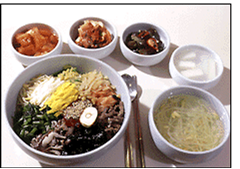What's Happening
‘A Sampling and demonstration of Bibimbap, part of Korea’s cultural cuisine’ (Sunday 12th September at 6.15pm)
- Date09/09/2010
- Hit11455

The Korean Cultural Centre has a
significant presence on Jubilee Gardens as part of this year's Thames
Festival 11th & 12th September. There will be demonstrations of Taekwondo,
music, dance and crafts. The Korea Tourism Organization is sponsoring a 'Taste
of Korean food Bibimbap' experience and visitors will be able to sample
the exquisite taste of one of Korea's most famous dishes and witness the
traditional table settings that Korean cuisine demands. The event takes place in
the 'Workshop tent' beside the All Eyes of Korea Stage which is on Jubilee
Gardens by London Eye.
Bibimbap is regarded as one of the most gorgeous
traditional dishes in Korea. So join us on a journey of
discovery and find out about this spectacular dish.
If you think that Bibimbap is just a dish of mixed rice, ‘namul’ (seasoned vegetables and herbs) and ‘gochujang’ (red pepper paste) then you are wrong. Within Bibimbap, locally obtained bean sprouts are the main ingredient to be added to rice and the rice is cooked in beef broth. Just before the rice is fully cooked, bean sprouts are mixed with the rice and then the other ingredients such as ‘mung’ bean curd, raw beef and nuts are put on top.
In choosing the ingredients the colour is also considered carefully, according to traditional cosmology: each direction of the compass, the precise location of the diner and what season it happens to be are all indicated by the use of 5 basic colours, which are blue (and green), red, yellow, white and black. Blue symbolizes the east, yellow is the spot where one happens to be standing and also the earth; white signifies the west and autumn; and black is for north and winter. So people used to believe that having a bowl of Bibimbap meant one was absorbing the energy of the universe.
- prevThe Korea Tourism Organization announces partnership with UK Sport Taekwondo10/06/2010
- nextUNESCO Inscribes Korea’s 10th Site On World Heritage List - Historic Villages Of Korea: Hahoe And Yangdong08/09/2010
